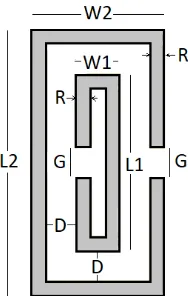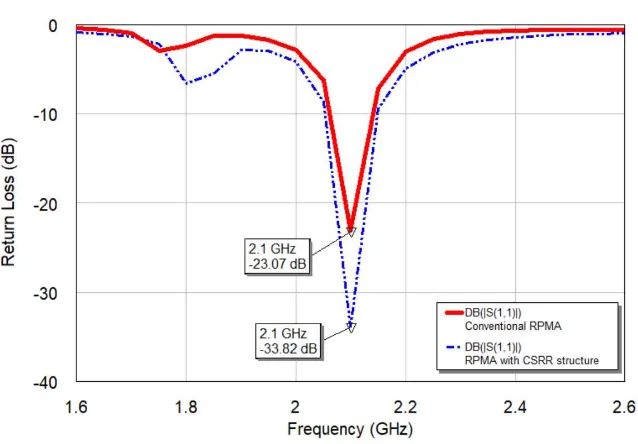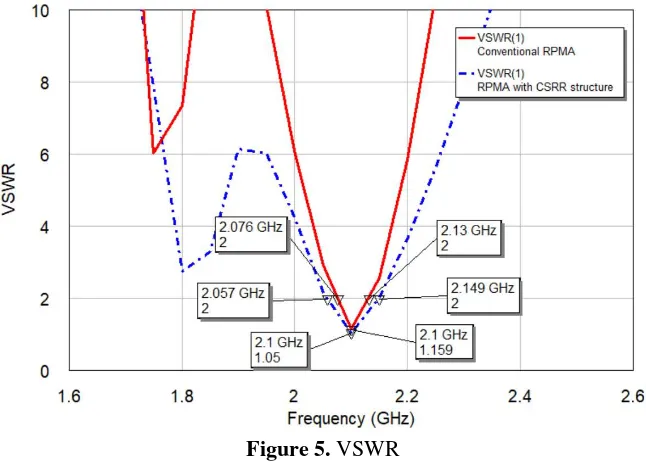IOP Conference Series: Materials Science and Engineering
PAPER • OPEN ACCESS
Miniaturization of rectangular patch microstrip antenna by using
complementary split ring resonator
To cite this article: Ali Hanafiah Rambe et al 2018 IOP Conf. Ser.: Mater. Sci. Eng.420 012132
View the article online for updates and enhancements.
1234567890‘’“”
2nd Nommensen International Conference on Technology and Engineering IOP Publishing IOP Conf. Series: Materials Science and Engineering 420 (2018) 012132 doi:10.1088/1757-899X/420/1/012132
Miniaturization of rectangular patch microstrip antenna by using
complementary split ring resonator
Ali Hanafiah Rambe1, Habib Muharry2, Raja Harahap2, Suherman Suherman1
1Department of Electrical Engineering, Universitas Sumatera Utara, Indonesia 2 Master Student at Department of Electrical Engineering, Universitas Sumatera
Utara, Indonesia
Abstract. The mobile device miniaturization requires the applied antenna microstrip size be much smaller to reduce the radio front-end load. This paper discusses the rectangular patch microstrip antenna miniaturization by using complementary split ring resonator (CSRR) structure for 3G mobile communication system on 2.1 GHz. The structure is implemented on the microstrip ground plane. Simulation evaluation by using the AWR simulator shows that the CSRR structure is able to reduce antenna dimension about 62.71%
from 3192 mm2 (56mm×57mm) to 1190 mm2 (34mm×35mm). Beside
miniaturization, VSWR and return loss also experience improvements about 1.05 and -33.83 dB subsequently. Bandwidth increment about 70.37% is also achieved.
1. Introduction
Generally, antenna dimension is inversely proportional to the working frequency. The lower the working frequency, the greater the antenna the antenna size. This problem emerges on mobile wireless applications on ultra-high frequency (UHF) band of 300 MHz – 3 GHz. The smaller size antenna dimension is preferred to support miniaturized devices such as handphones and tablets.
Some existing methods in miniaturizing the antenna dimension such as defected ground structure (DGS) [1],[2], fractal [3] [4] and metamaterial [5] [6] have been proposed. This paper focuses on the use the complementary split ring resonator (CSRR) for reducing the rectangular patch microstrip antenna (RPMA) working on wide band code division multiple access (WCDMA) frequency band of 2.1 GHz. The CSRR method has been implemented in [7] to reduce the 50% antenna dimension. The evaluated antenna is realized by using FR4 substrate with dielectric constant of 4.4 and 1.6 mm thickness.
2. The RPMA design equations
The RPMA design is initiated by defining the antenna dimension that works on the expected frequency: patch width and length. These sizes are correlated with the effective substrate dielectric constant (εreff) which is determined by the Equation 1 [8], [9]):
(1)
So that the antenna length (L) is calculated by using Equation 2:
2 1234567890‘’“”
2nd Nommensen International Conference on Technology and Engineering IOP Publishing IOP Conf. Series: Materials Science and Engineering 420 (2018) 012132 doi:10.1088/1757-899X/420/1/012132
With the (additional patch length) is defined as:
(3)
(4)
In order to obtain microstrip patch width (W), Equation 5 is employed [8], [9]:
(5)
where c is light speed 3×108 m/s, r is substrate dielectric constant, fr is resonant frequency, h
is substrate thickness and Leff is effective patch length.
3. The CSRR design
Figure 1 illustrates the CSRR design implemented throughout this paper. The CSRR appears like a rectangular ring with the thickness R separated by a gap (G) placed on the antenna ground plane. The CSRR implementation is initiated by etching the inner ring with size of W1 and L1. Afterwards, the outer ring is added (W2 and L2). Both rings are separated by distance of D. To realize the expected design, the structure dimension are selected by using W2=9mm, L2=18mm, W1=3mm, L1=13mm, R=1mm, D=2mm and G=2mm.
Figure 1. The CSRR structure
4. Simulation Results
Figure 2 shows the conventional RPMA design for wireless applications on 2.1 GHz. The optimum result is achieved with conventional RPMA dimension of 57×56 mm2 and rectangular patch of 40×34 mm2.
Figure 3 shows the RPMA design with CSRR structure. Based on the optimal result given by simulation, the RPMA with CSRR structure has dimension of 35×34 mm2 and rectangular patch of 28×16 mm2. By using this size, the expected design is achieve, this means the CSRR is successfully minimizing the RPMA dimension as 35×34 mm2 is lower than 57×56 mm2.
1234567890‘’“”
2nd Nommensen International Conference on Technology and Engineering IOP Publishing IOP Conf. Series: Materials Science and Engineering 420 (2018) 012132 doi:10.1088/1757-899X/420/1/012132
(a) top view (b) button view
Figure 2. Conventional RPMA
(a) top view (b) button view
Figure 3. RPMA with CSRR structure
4 1234567890‘’“”
2nd Nommensen International Conference on Technology and Engineering IOP Publishing IOP Conf. Series: Materials Science and Engineering 420 (2018) 012132 doi:10.1088/1757-899X/420/1/012132
Figure 5. VSWR
The return loss value on resonant frequency of 2.1 GHz of the conventional RPMA is -23.07dB. The CSRR structure implementation on the ground plane causes the return loss value decreases to -33.82dB. Meanwhile, the bandwidth of the conventional RPMA on VSWR ≤ 2 is 54 MHz (2.13 GHz – 2.076 GHz) and the minimum VSWR is 1.159. These values are improved by CSRR structure addition, where the bandwidth of VSWR ≤ 2 becomes 92 MHz (2.149 GHz – 2.057 GHz) with minimum VSWR is 1.05.
Table 1. Antenna dimension comparison
Conventional RPMA RPMA with CSRR
structure Annotation Antenna dimension 57×56 mm (3192 mm2) 35×34 mm (1190 mm2) Reduction=62.17%
Patch Dimension 40×34 mm (1360 mm2) 28×16 mm (448 mm2) Reduction=67.06%
Bandwidth 54 MHz 92 MHz Enhancement=70.37%
5. Conclusion
This paper has evaluated the RPMA miniaturization by using the CSRR structure implemented on the RPMA ground plane. Based on simulation results, the CSRR structure is able to reduce the RPMA dimension up to 62.17% compared to the conventional one when working on 2.1 GHz. The rectangular patch dimension is also experiencing reduction by 67.06%. Furthermore, the obtained bandwidth is also greater, achieving 92 MHz, compared to only 54 MHz in conventional RPMA. These facts prove that the CSRR structure is able to minimize the RPMA dimension on the assessed WCDMA frequency of 2.1 GHz.
6. Acknowledgment
1234567890‘’“”
2nd Nommensen International Conference on Technology and Engineering IOP Publishing IOP Conf. Series: Materials Science and Engineering 420 (2018) 012132 doi:10.1088/1757-899X/420/1/012132
7. References
[1]. Pandhare, R.A., Zade, P L., Abegaonkar, MP. (2016). Miniaturized microstrip antenna array using defected ground structure with enhanced performance. Engineering Science and Technology, an International Journal. 19 (2016). pp 1360–1367.
[2]. Jaisawal, R. K., Pandey, A., and Chauhan, R. K. (2015). A Review: Size Reduction in Microstrip Patch Antenna using Defected Ground Structure. i-manager’s Journal on Communication Engineering and Systems. 4(2). pp 12-16.
[3]. Shareef, A.N. and Shaalan, A.B. (2016). Size Reduction of Microstrip Patch Antenna by Using Meta-Fractal Technique. International Journal of Latest Engineering Research and Applications. Volume 01. Issue 04, pp 21-27.
[4]. Zulfin, M., Rambe, A.H., and Budi, B. (2018). Design and analysis microstrip dipole using fractal Koch for 433 MHz applications. IOP Conf. Ser.: Mater. Sci. Eng. 309 012047.
[5]. Singh, A.K., Abegaonkar, M.P., and Koul, S.K. (2018). Miniaturized Multiband Microstrip Patch Antenna Using Metamaterial Loading for Wireless Application. Progress In Electromagnetics Research C, Volume 83. pp 71–82.
[6]. Mehrparvar, M. and Kashani, F. H. (2012). Microstrip Antenna Miniaturization Using Metamaterial Structures. 20th Iranian Conferance on Electrical Engineering. May 15-17. Tehran. Iran.
[7]. Amrutha M and Thomas, A. (2015). Miniaturization of Microstrip Patch Antenna Using CSRR. IOSR Journal of Electrical and Electronics Engineering. Volume 10. Issue 4 Ver. III (July – Aug. 2015). pp 16-20.
[8]. Balanis, C.A. (2005). Antenna Theory: Analysis and Design (Canada: Jhon Wiley & Sons).
[9]. Rambe, A.H. and Abdillah, K. (2017). A Low Profile Rectangular Patch Microstrip Antenna for Dual-band Operation of Wireless Communication System. IOP Conf. Ser.: Mater. Sci. Eng. 309 012046.


